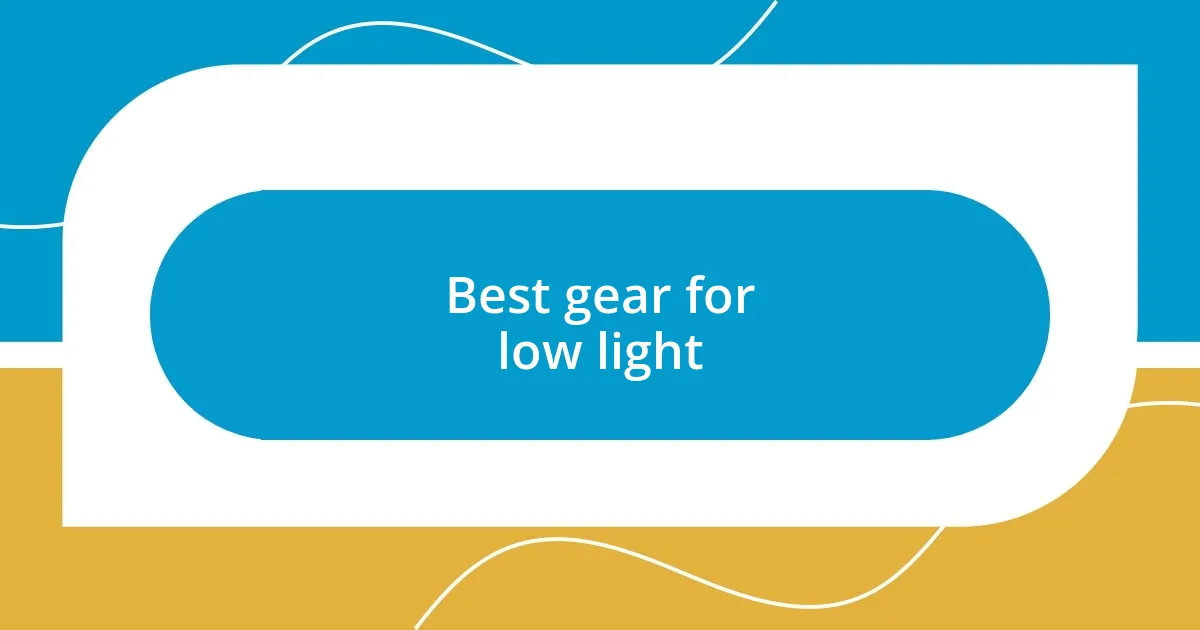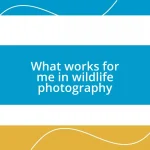Key takeaways:
- Adapting to low light enhances the use of other senses, leading to a heightened appreciation of detail and atmosphere.
- Essential gear for low light includes quality flashlights, fast camera lenses, and headlamps to improve safety and experience.
- Techniques for improved visibility, such as using reflective gear and strategic lighting, can significantly boost confidence in low-light situations.
- Evaluating experiences and feedback from others helps refine low-light techniques and enhances future outings.

Understanding low light conditions
Low light conditions can be tricky, and I’ve often found myself adjusting to various textures and colors around me. It’s fascinating how my eyes gradually adapt, but sometimes, I still stumble while searching for that elusive light switch or navigating unfamiliar spaces. Isn’t it interesting how our body’s instincts kick in, urging us to rely more on other senses, like touch and hearing?
I remember a time when I was hiking at dusk, surrounded by looming trees and fading light. The shift from daylight to twilight made every sound feel amplified, almost as if the woods were whispering secrets. That experience taught me to slow down and truly appreciate the subtle details often overlooked in brighter conditions. Have you ever noticed how shadows can create shapes that spark your imagination when visibility is limited?
Understanding low light isn’t just about the absence of brightness; it’s about recognizing how it changes our perception and interaction with the world. I sometimes find myself feeling a mix of excitement and trepidation in dim settings, wondering how the atmosphere shifts our mindset. It pushes us to view our surroundings in a different light—quite literally!

Best gear for low light
When it comes to the best gear for low light, I’ve discovered that a quality flashlight can be a game-changer. I remember one camping trip where my trusty LED flashlight guided me safely to my tent through a dense forest. Not only did it illuminate my path, but it also made me feel secure amidst the shadows, heightening my sense of adventure.
In addition to a flashlight, investing in a fast lens for my camera has dramatically improved my nighttime photography. There’s something magical about capturing those fleeting moments in low light, where every subtle flicker of light can transform a mundane scene into an evocative image. Once, while trying to photograph a fireworks display, I switched to my 50mm f/1.8 lens and was amazed at how much clearer and more vivid the colors appeared, even against the dark sky.
Lastly, a good quality headlamp is invaluable for hands-free tasks. I’ll never forget the time I had to fix a flat tire after sunset. With both hands busy and only my headlamp lighting the way, I could navigate the tools effortlessly. It truly freed me up to focus on the task at hand while still shedding light on my surroundings, proving how essential it is to have the right gear when you’re tackling low light challenges.
| Gear | Benefits |
|---|---|
| LED Flashlight | Portable and powerful for guiding paths and enhancing safety. |
| Fast Camera Lens (f/1.8 or lower) | Great for capturing vibrant images in low light settings, allowing more light to enter. |
| Headlamp | Hands-free operation, perfect for tasks requiring both light and mobility. |

Techniques for improved visibility
Finding ways to improve visibility in low light can dramatically enhance not just safety but also the enjoyment of our surroundings. One technique I’ve found effective is to use reflective materials. For instance, when prepping for evening walks, I’ve attached reflective strips to my backpack. The way they catch even the slightest light makes me feel more at ease, knowing that I’m more visible to others without overwhelming the natural ambiance of my environment.
Here are some practical techniques I’ve relied on for better visibility:
- Use Reflective Gear: Employ clothing and accessories that enhance your visibility, especially when walking or biking at night.
- Strategic Lighting: Consider strategic placement of outdoor lights or lanterns to create a path. I’ve found that soft lighting not only guides me but also creates an inviting atmosphere.
- Night Vision Apps: Some smartphone apps adjust screen brightness and enhance low-light visibility, which I’ve leveraged when searching for paths on evening hikes.
- Colored Filters: Applying colored filters to your light source can help reduce glare while providing enough illumination—an option I’ve experimented with during my photography sessions.
- Mindful Slowing: Slowing down and being deliberate when moving through low-light areas helps me to absorb my surroundings and avoid missteps. It also opens my senses to appreciate the sounds and smells that often go unnoticed during the day.
Adopting these techniques has transformed my experience in low-light situations, amplifying my confidence and enjoyment as I navigate through them.

Using technology in low light
Using technology to navigate low light can truly elevate my experience outdoors. I love utilizing smartphone apps, like GPS or flashlight features, to enhance my visibility when heading out at night. Just the other evening, I used a navigation app during a hike, and it was a game-changer; instead of relying solely on sometimes tricky trails, I felt empowered seeing my exact location illuminated in the dark. It made me wonder, how did I ever manage without this tech before?
Another tool I’ve found invaluable is a compact, portable lantern. I remember camping under the stars where we gathered around a small lantern that provided not just light but a cozy atmosphere. Its warm glow created a circle of community, allowing us to share stories while the night closed in. Isn’t it interesting how a simple piece of technology can transform a gathering?
Finally, I can’t stress enough the importance of learning to leverage my camera settings when shooting in low light. There was a magical moment during an evening event where I captured the soft glow of string lights. By adjusting the ISO and slowing down the shutter speed, I made the most of the subtle illumination, bringing the scene to life. When I review those photos, I feel a rush of pride and nostalgia, and it always leaves me questioning—what other memories can I capture with the right technology?

Evaluating your low light results
When evaluating my low-light results, I often find it helpful to look back at my experiences and reflect on what stood out. I remember one evening while experimenting with different light angles during a backyard gathering. The way shadows danced and focused on certain areas created a warm, inviting space, which made me appreciate the role of light even more. How did that simple adjustment change the entire mood?
I also pay attention to the feedback I receive from friends during these low-light adventures. One time, while walking with a friend on a dimly lit trail, they mentioned how the soft glow from my reflective gear helped guide their path. Their reaction made me realize that visibility impacts not just me but also those around me. It’s a reminder that evaluating our low-light techniques is as much about others’ experiences as it is about our own.
Lastly, I frequently assess the photographs I take in low light to gauge my success. There was a night when I captured an incredibly vibrant sunset, but I noticed that the foreground felt too dark. This taught me the importance of balancing exposure and composition. With every click of the shutter, I’m reminded: what can I adjust next time to enhance what I see? It’s all a part of the learning process, continuously improving each outing based on the results I observe and experience.














